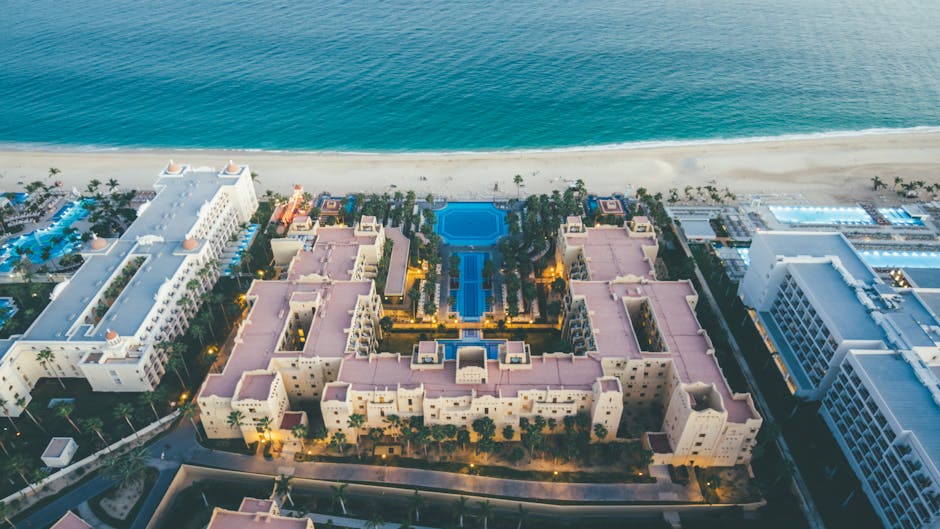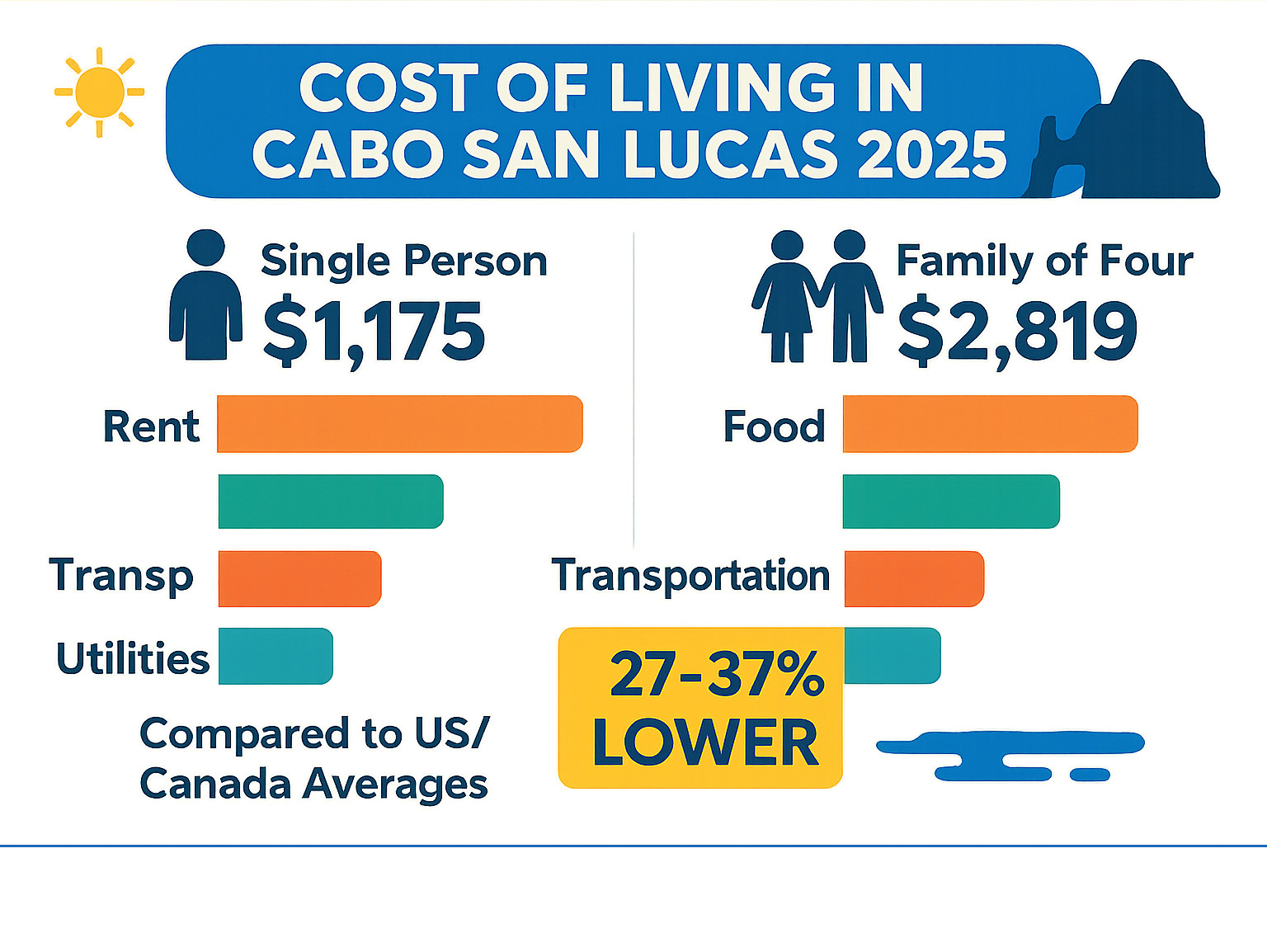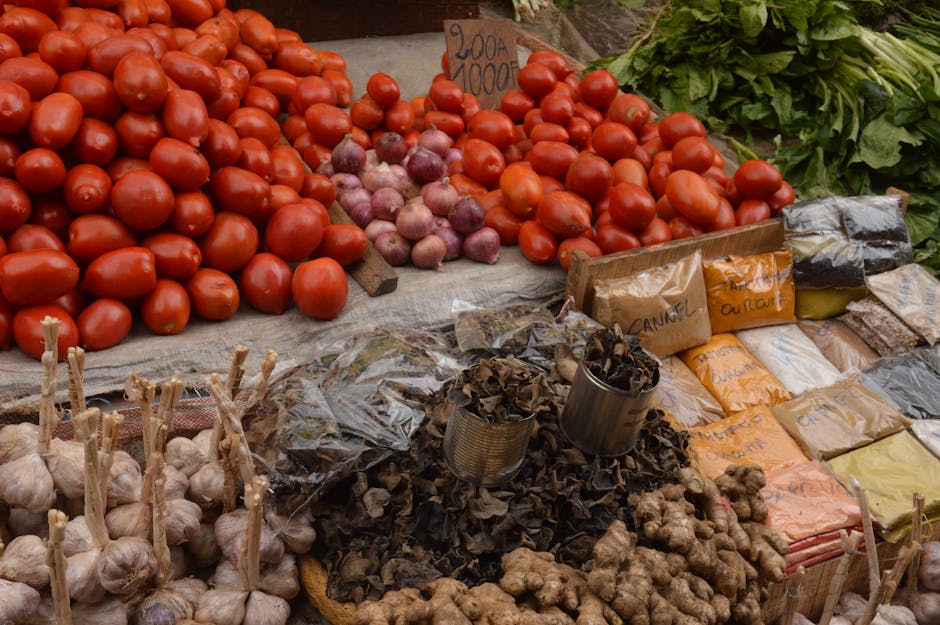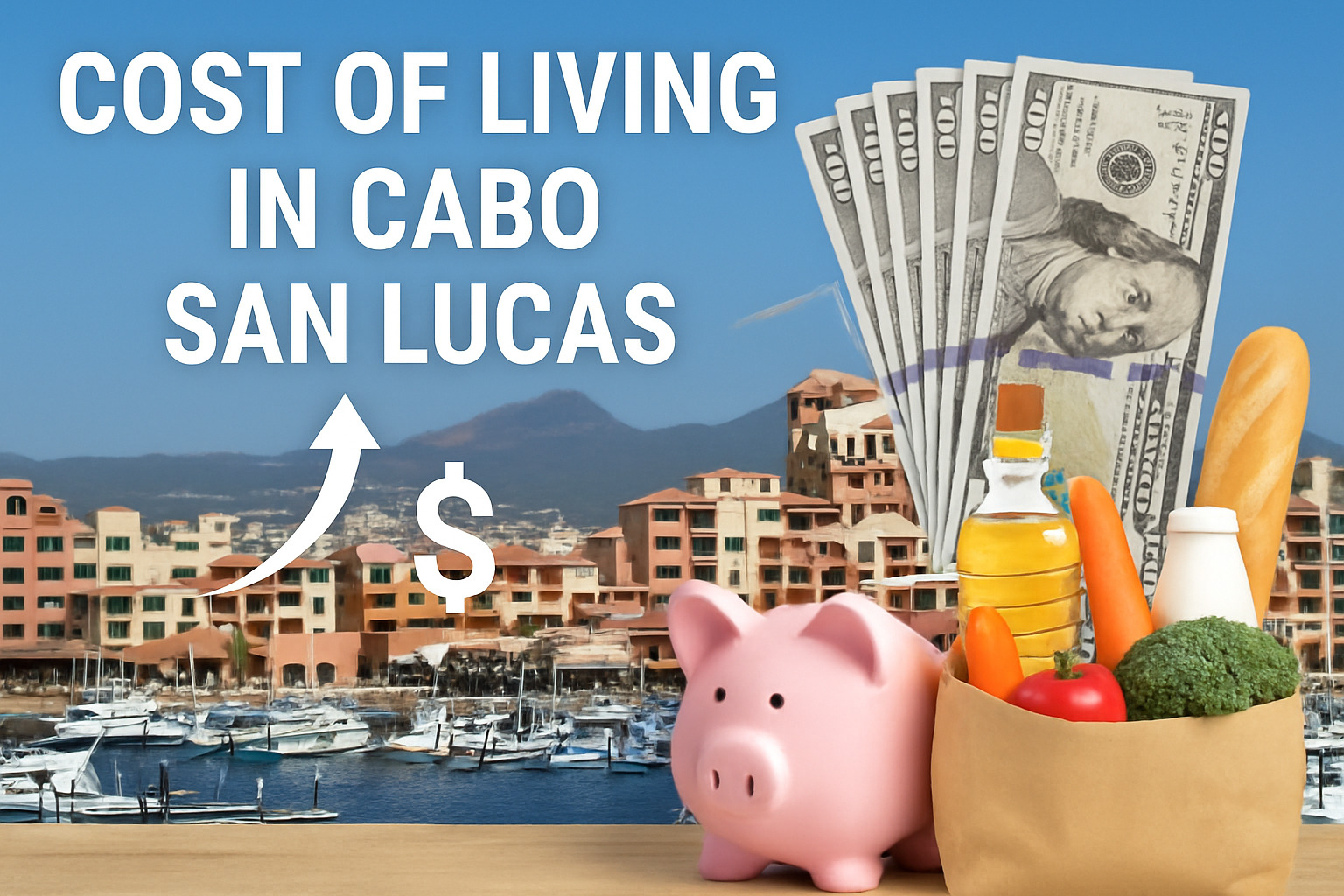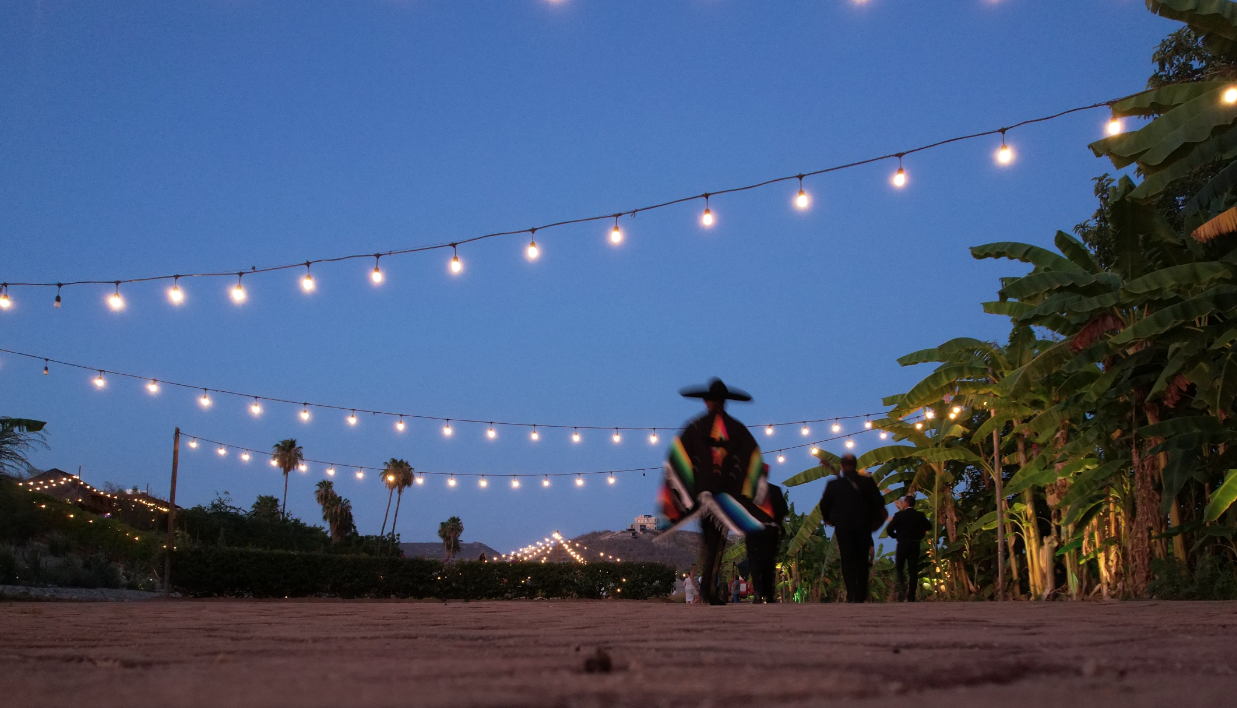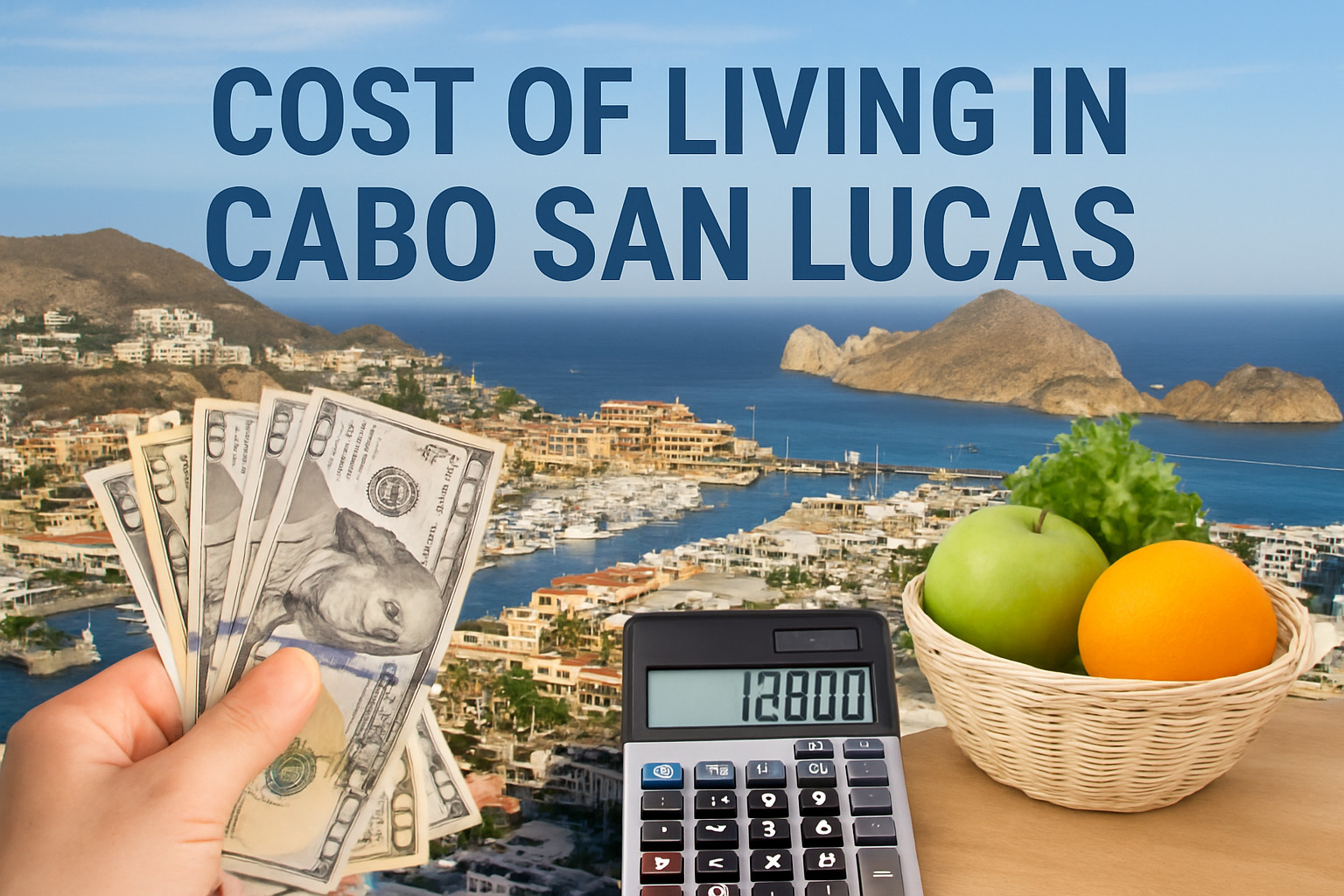Why Understanding the Cost of Living in Cabo San Lucas Matters
The cost of living in Cabo San Lucas is approximately 27-37% cheaper than the United States and Canada, making it an attractive destination for expats, retirees, and digital nomads seeking paradise on a budget.
Quick Cost Overview:
- Single person monthly costs: $1,175 USD (including rent)
- Family of four monthly costs: $2,819 USD (including rent)
- Average rent (1-bedroom city center): $666 USD/month
- Average rent (3-bedroom city center): $1,694 USD/month
- Average monthly salary: $848 USD after tax
Whether you’re planning a permanent move to Los Cabos, considering a long-term stay, or simply curious about what it costs to live in this stunning destination, understanding the real numbers helps you make informed decisions. From the busy marina life of Cabo San Lucas to the laid-back charm of San José del Cabo, the region offers diverse lifestyle options at surprisingly affordable prices.
Housing costs are significantly lower than North American cities, with groceries 42% cheaper than Canada and restaurant meals starting around $14 USD. However, utilities can be higher due to air conditioning needs, and imported goods carry premium prices.
The data reveals that while the median salary covers basic living expenses, many expats and retirees find their foreign income stretches much further here than in their home countries. This economic advantage, combined with year-round sunshine and proximity to world-class beaches, explains why Los Cabos continues attracting international residents.
Detailed Cost of Living in Cabo San Lucas: Housing, Food, Transport & More
Rent & Real Estate Costs: True “Cost of Living in Cabo San Lucas” Breakdown
When you’re considering a move to paradise, housing costs are probably your biggest question mark. The good news? The cost of living in Cabo San Lucas for housing will likely make you smile. We’re talking about rent prices that are 66.4% lower than Toronto for similar accommodations.
Let’s talk real numbers. A one-bedroom apartment in the city center averages $666 USD monthly, though you’ll find options ranging from $500 to $1,000 depending on amenities and exact location. If you’re willing to live outside the busy center, that drops to around $450-$800 USD. For families, a three-bedroom city center apartment runs about $1,694 USD, with a range of $1,200-$2,500 based on your specific needs.
Now, if you’re dreaming of that gated community lifestyle, places like Pedregal or Quivira offer three-bedroom homes for around $3,000 USD monthly. Yes, it’s pricier, but you’re getting security services and often spa amenities that make it feel like living in a resort.
The property purchase market is equally attractive. You’re looking at $151 USD per square foot in the city center and $120 USD outside the center. Here’s where it gets really interesting for retirees: property taxes (called predial here) are only about 0.1% of your property’s value annually. That $500,000 dream home? Just $500 yearly in property taxes. But wait, it gets better – with early payment discounts (20%) and senior discounts (30%), that could drop to just $250 per year. Try finding that deal back home!
The choice between Cabo San Lucas and San José del Cabo affects your housing costs too. Cabo San Lucas gives you that vibrant marina lifestyle with slightly higher prices, while San José del Cabo offers laid-back charm with gentler rent prices. The Corridor between them? That’s where you’ll find resort-style living at premium prices.
More info about Los Cabos Real Estate
Food & Dining Costs: Tasting the “Cost of Living in Cabo San Lucas”
Here’s where your wallet will really thank you for moving to Los Cabos. Groceries cost 41.8% less than in Canada, and when you find the local farmers’ markets, you’ll wonder why you ever paid North American prices for produce.
Restaurant dining offers incredible variety for your budget. A basic lunch menu in the business district runs about $14 USD, while a nice dinner for two at a mid-range restaurant costs around $72 USD. Craving fast food? Combo meals are about $9 USD. And yes, you can enjoy a domestic beer with your meal for just $2-3 USD.
Your morning cappuccino habit won’t break the bank at $3-4 USD, especially when you’re sipping it with ocean views that would cost triple elsewhere.
Grocery shopping is where the real savings shine. Chicken breast costs about $3.50 USD per pound, local cheese runs $4.50 USD, and a gallon of milk is $3.50 USD. Basic staples like rice ($1.20 per pound), eggs ($2.50 per dozen), and fresh tomatoes ($1.50 per pound) make home cooking incredibly affordable.
The secret to maximizing your food budget? Shop like a local. Those Mexican staples – rice, beans, tortillas, local cheeses, and seasonal fruits – offer the best value. Many expat families report spending just $300-400 monthly on groceries for four people. Import lovers, beware: specialty cereals, wine, and international brands carry premium prices.
Local farmers’ markets are your best friend, offering fresh produce often 30-50% cheaper than supermarkets. Plus, you’ll get that authentic local experience that makes living here so special.
Utilities, Internet & Other Essentials
Utilities in the cost of living in Cabo San Lucas are a mixed bag, but mostly in a good way. Your basic utilities (electricity, water, garbage) for a 915 square foot apartment average about $64 USD monthly. However, here’s the reality check: air conditioning during summer months can push your electricity bill to $100-150 USD or even higher.
Many rental properties bundle utilities, which simplifies budgeting and often saves money. Water costs vary wildly from $5-60 USD depending on whether it’s bundled with other services.
For digital nomads and remote workers, you’ll be happy to know internet infrastructure has improved dramatically. Reliable 60+ Mbps connections cost $35-50 USD monthly, making work-from-paradise totally feasible. Starlink is becoming more common and faster for around $150 USD monthly.
The summer electricity spike is real – many residents see their bills double or triple from May through October when air conditioning runs constantly. Budget accordingly, or accept the tropical lifestyle with fans and open windows.
Scientific research on remote work
Getting Around: Transportation Costs
Transportation costs in the cost of living in Cabo San Lucas are reasonable, though slightly higher than other Mexican destinations. The local bus system is your budget-friendly option at just $0.77 USD per ride. If you’re planning to use public transport regularly, a monthly pass costs $58 USD.
Local buses (colectivos) connect major areas throughout Los Cabos efficiently. However, many expats prefer the convenience of taxis, which cost about $25 USD for an 8-kilometer ride. Gasoline runs $1.18 USD per liter, similar to U.S. prices.
If you’re considering buying a car, a new Volkswagen Golf equivalent costs about $18,000 USD. Add insurance ($500-1,000 annually) and registration ($200-300 annually), and you’re still looking at reasonable transportation costs.
For newcomers, we’ve found that reliable airport transportation makes settling in much smoother. At SJD Taxi, we offer both shared shuttles ($13-40 USD per person depending on destination) and private transfers. Our private transfers include those thoughtful touches like grocery stops and complimentary beverages that help make your “welcome to Los Cabos” moment special and stress-free.
More info about Cabo Private Transportation
Living Affordably in Paradise: Comparisons, Salaries & Smart Savings
Cabo vs. Mexico, U.S. & Canada: How Salaries and Purchasing Power Compare
When you dig into the real numbers, the cost of living in Cabo San Lucas becomes even more compelling. We’re talking about genuine savings that make a difference in your monthly budget – 36.6% cheaper than the United States overall, with some categories offering even deeper discounts.
The restaurant scene alone will surprise you. Dining out costs 38.3% less than what you’d pay in the U.S., while your grocery bill drops by a whopping 44.2%. Housing delivers the biggest punch with 58.5% savings, and if you have kids, childcare costs are 72% lower. Transportation and clothing stay roughly the same, so you’re not sacrificing convenience.
Here’s where it gets interesting – and a bit complicated. The average monthly salary in Cabo sits at $848 USD, while Toronto workers earn $3,568 USD monthly. That’s a 249% difference that sounds scary until you consider purchasing power.
Most expats and retirees aren’t relying on local salaries anyway. They’re bringing foreign income, pensions, or remote work paychecks. A $3,000 USD monthly income provides a comfortable middle-class lifestyle in Cabo, equivalent to needing $5,000-6,000 in many U.S. cities.
Within Mexico, Cabo San Lucas ranks as the 5th most expensive city out of 144, but that premium buys you something special. You’re getting better tourism infrastructure, improved security, and that unbeatable proximity to the U.S. border. Compare it to Mazatlán (23% cheaper) or Puerto Vallarta (similar costs), and you’ll see why many choose Los Cabos despite the slight premium.
| Category | Cabo San Lucas | United States | Canada | Savings |
|---|---|---|---|---|
| 1-bed apartment (center) | $666 USD | $1,430 USD | $1,200 USD | 53-44% |
| Restaurant meal | $14 USD | $25 USD | $20 USD | 44-30% |
| Groceries (monthly) | $300 USD | $500 USD | $450 USD | 40-33% |
| Utilities | $64 USD | $120 USD | $110 USD | 47-42% |
| Transportation | $58 USD | $70 USD | $85 USD | 17-32% |
The numbers tell a clear story – your money simply goes further here. Whether you’re comparing against major Canadian cities or U.S. metropolitan areas, the cost of living in Cabo San Lucas delivers genuine value without compromising on quality of life.
Scientific research on global cost indices
Money-Saving Hacks, Tax Perks & When SJD Taxi Makes Sense
Smart expats have finded some clever ways to stretch their pesos even further. The cost of living in Cabo San Lucas drops significantly when you know the local tricks, and we’ve watched countless residents master these strategies over the years.
Property tax game-changer alone can save you hundreds annually. Pay your predial taxes in January for an automatic 20% discount, then stack on another 30% senior discount if you qualify. That $500 annual tax bill on a half-million-dollar property? It drops to just $250 with both discounts applied.
Shopping seasonally makes a huge difference too. The off-season months from May through October bring better deals on everything from rent negotiations to restaurant specials. Yes, it’s hotter, but your wallet stays cooler.
Local farmers’ markets become your best friend for fresh produce at 30-50% below supermarket prices. Many expats report spending just $300-400 monthly on groceries for a family of four by shopping like locals do – focusing on Mexican-produced staples like rice, beans, tortillas, and seasonal fruits.
Bundled utility services save you from surprise bills, especially important when air conditioning costs spike during summer months. Look for rental properties that include utilities in the monthly rate for easier budgeting.
For transportation, the strategic approach works best. Use local buses for daily trips around town at less than $1 per ride, then reserve taxis for special occasions or when you’re loaded down with groceries.
Tax advantages for retirees deserve special mention. Mexico offers significant breaks including reduced property taxes and favorable exchange rates. Many retirees report their overall tax burden dropping 40-60% compared to their home countries – money that goes directly back into their lifestyle budget.
Healthcare costs add another layer of savings. Doctor visits run $25-50 USD, prescription medications cost 50-70% less than U.S. prices, and private health insurance ranges from $100-300 USD monthly. Dental care delivers 60-80% savings, making it worthwhile for many to handle major dental work here.
Entertainment stays affordable too. Gym memberships cost $35-50 USD monthly, movie tickets run $4-6 USD, and spa services offer 40-60% savings compared to U.S. prices. Even golf at public courses costs $80-120 USD, reasonable for the quality you get.
The key to living affordably in Los Cabos is embracing the local lifestyle while maintaining the comforts you need. Many expats find they can live better here on less money than they spent back home, thanks to lower housing costs, affordable healthcare, and year-round outdoor activities that don’t cost extra.
Your lifestyle choices significantly impact your final costs. Living like a local, shopping smart, and taking advantage of available discounts can reduce expenses even further. Whether you’re planning a permanent move, extended stay, or just curious about the numbers, the cost of living in Cabo San Lucas offers exceptional value for those seeking a high-quality lifestyle in paradise.
For those making the transition, reliable transportation sets the foundation for a successful move. We’re here to help make your arrival in Los Cabos as smooth and budget-friendly as possible, because starting your new life shouldn’t break the bank.

